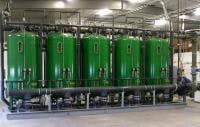The city of Goodland, Kan., is one of the last stops in the state before entering Colorado. Nitrate levels in the nine city wells were growing over time, and city personnel decided to evaluate technologies available to remove the nitrates.
The nitrates in the wells varied from 4 to 5 mg/L to more than 13 mg/L, while the maximum contaminant level for nitrates is 10 mg/L.
When grant funds were made available through the American Recovery and Reinvestment Act (ARRA), Goodland’s engineer out of Pratt, Kan., decided to submit design plans and specifications to the Kansas Department of Health and the Environment (KDHE) in just a few months. The resulting $5.7 million project was the largest ARRA water treatment project in the state. The nitrate treatment system made up slightly more than 10% of the total project cost.
The city’s engineer considered both reverse osmosis (RO) and ion exchange (IX) for the 1,650-gal-per-minute (gpm) blended effluent nitrate removal design. They decided the 20% to 25% waste volume of RO was not acceptable, and after visiting IX plants, they decided to use the Layne design concept for its less than 0.6% small waste volume and low salt usage.
KDHE required the city to dispose of the waste brine into a double-lined stabilization pond. These are expensive and the low waste feature by Layne allowed for the smallest brine pond possible, which saved the project hundreds of thousands of dollars compared to conventional IX treatment.
Testing the System
A pilot study was required by KDHE to verify the low waste volume and the system’s high liquid loading rate (LLR) of 20 to 22 gpm per sq ft. This LLR is about 3 times higher than the 6 to 8 gpm per sq ft LLR suggested by 10 states and also used by KDHE in their regulations. The pilot study was successfully completed in January 2010, indicating about 0.5% waste volume could be achieved on a consistent basis, and the LLR of 20 gpm per sq ft met the projected nitrate removal with an approximate 11-hour filter run before breakthrough of the nitrates into the effluent.
A performance specification to achieve less than 0.6% waste volume was put out to bid and five organizations responded with their best design approach. Layne was lowest price, met the specification requirements and could list about 13 high-rate and low-waste installations in the U.S. for reference.
Nitrate treatment plants typically treat part of the influent and bypass a portion of untreated influent, which is then blended with the treated effluent. This results in a blended effluent that meets the design requirement of less than 8 mg/L. The Layne process considers breakthrough to occur, causing regeneration of a vessel, when the effluent nitrates from the treatment skid approach 2 to 3 mg/L. This approach allows for a more consistent blending of untreated water with the treatment skid effluent to achieve a final effluent nitrate value of less than 7 to 8 mg/L going into the system for distribution to the city residents.
The final design preferred the treatment skid approach used by Layne. Five 4-ft-diameter pressure vessels were pre-assembled onto a treatment skid resulting in a system about 24 ft long by 6 ft wide. All of the piping and valves were assembled on the skid, including wiring of the electric valves and instruments to a junction box on the skid, which was connected to the remote free standing main control panel (MCP). The treatment skid is set into place by a crane, and after pipe connections are made, resin installed and connections made to the MCP, the installation of the treatment skid is complete.
An Effective Solution
The Layne High Rate/Low Waste system recovers and recycles part of the rinse water and the only waste is the nitrate- and sulfate-laden brine going to the waste tank of more than 1,200 gal per regeneration of a vessel. The vessels and tanks included in the low-waste system, other than the treatment skid vessels and pre-filters, include the waste, recycle and brine tanks.
Each of these tanks has associated pump skids with flowmeters provided by Layne as part of the system design. By using this system approach to equipment provision, the city only has one phone call to make if they have questions about control and system operation. They simply call Layne.
System results to date have achieved a consistent nitrate blended effluent of less than 8mg/L, and depending on which of the nine wells are being used, the results can be less than 6 mg/L. The overall waste percentage has stayed around 0.3%, which is about half the required 0.6% given in the design specifications.
The plant operator can determine the amount of bypass allowed by using either an effluent nitrate analyzer to control the bypass volume or by the operator setting a percentage of bypass volume. The nitrate analyzer is set up to evaluate the influent, blended effluent and treatment skid effluent nitrate values, which are recorded in the SCADA system supplied. During high demand in the summer, the plant has been able to supply up to 2,500 gpm of blended effluent while meeting the less than 8 mg/L nitrate requirement.
The city and engineer made their building big enough to allow for two additional treatment skids if needed.
Ron Rappard is a water treatment specialist at Layne Christensen Co., Water Technologies Group. Rappard can be reached at [email protected].


